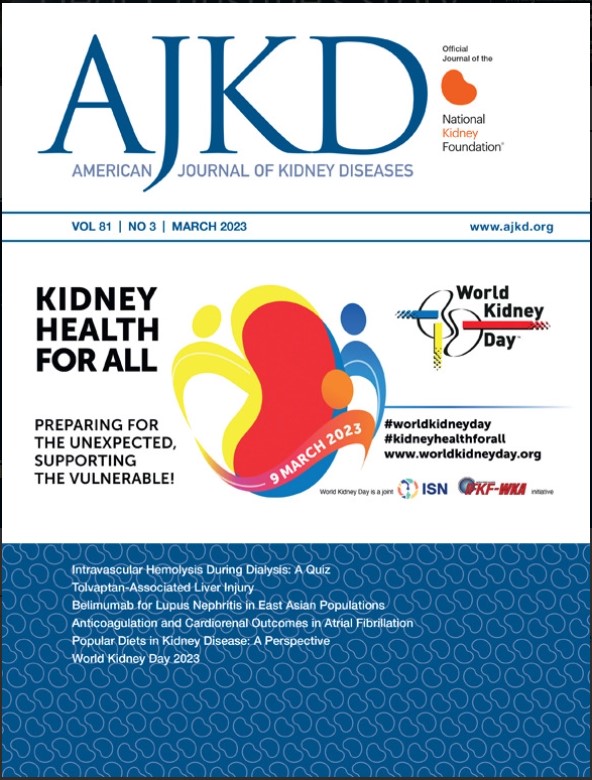肾小球滤过肌酐:验证老年人肌肉质量的新指标
IF 9.4
1区 医学
Q1 UROLOGY & NEPHROLOGY
引用次数: 0
摘要
理由与目的:低肌肉量在老年人中很常见,且与预后不良有关。定量肌肉质量在常规临床实践中具有挑战性。我们假设肾小球滤过肌酐(GFcr)反映肌肉质量,之前提出的估计GFcr (eGFcr)作为老年人肌肉质量的实用指标。本研究调查了测量的GFcr (mGFcr)和eGFcr是否与直接测量肌肉质量,大腿总肌肉瘦面积(TTMLA)相似。研究设计:基于社区的前瞻性队列横断面分析。背景和参与者:在AGES-Reykjavik研究中,共有794名患有mGFR和TTMLA的老年人。暴露:MGFcr,血清肌酐(Scr)和mGFR的乘积,通过血浆碘己醇清除率和eGFcr获得,Scr的乘积和血清胱抑素(eGFRcys)估计的GFR。结果:使用计算机断层扫描测量TTMLA。分析方法:使用连续和分类mGFcr和eGFcr进行性别特异性Pearson相关和线性回归分析。协变量包括人口统计、行为和临床变量以及合并症。结果:平均(SD)年龄为80.3(4.0)岁,mGFR为62.3 (16.5)mL/min/1.73 m2。与最高的分位数相比,mGFcr的最低性别分位数与男性的TTMLA降低14.6 (95% CI, 11.5-17.6)平方厘米/1.73 m2和女性的TTMLA降低7.9 (95% CI, 5.5-10.2)平方厘米/1.73 m2相关。eGFcr与TTMLA之间存在显著相关性。eGFcr与TTMLA的相关性通常与Scr和Scys衍生的其他指标的相关性一样强或更强。局限性:测量变量和未测量变量的残留混淆。结论:这些发现支持了GFcr作为老年人肌肉质量指标的有效性,以及eGFcr在临床环境中作为mGFcr的实用替代方案的有效性。本文章由计算机程序翻译,如有差异,请以英文原文为准。
Glomerular Filtration of Creatinine: Validation of a Novel Index of Muscle Mass Among Older Adults
Rationale & Objective
Low muscle mass is common among older adults and associated with poor prognosis. Quantifying muscle mass is challenging in routine clinical practice. We hypothesized that glomerular filtration of creatinine (GFcr) reflects muscle mass, and previously proposed estimated GFcr (eGFcr), as a practical index of muscle mass in older adults. This study investigated whether measured GFcr (mGFcr) and eGFcr are similarly associated with the direct measure of muscle mass, the thigh total muscle lean area (TTMLA).
Study Design
Cross-sectional analysis of a community-based prospective cohort.
Setting & Participants
A total of 794 older adults with measured glomerular filtration rate (mGFR) and TTMLA in the AGES-Reykjavik Study.
Exposure
Measured GFcr, the product of serum creatinine (Scr) and mGFR obtained using plasma iohexol clearance and eGFcr, the product of Scr and estimated glomerular filtration rate using serum cystatin C (Scys).
Outcome
TTMLA measured using computed tomography.
Analytical Approach
Sex-specific Pearson’s correlation and linear regression analyses using continuous and categorical mGFcr and eGFcr. Covariates included demographic, behavioral, and clinical variables, and comorbid conditions.
Results
The mean age and mGFR were 80.3 ± 4.0 (SD) years and 62.3 ± 16.5 (SD) mL/min/1.73 m2, respectively. The lowest sex-specific tertile of mGFcr, compared with the highest tertile, was associated with a 14.6 (95% CI, 11.5-17.6) cm2/1.73 m2 lower TTMLA in men, and a 7.9 (95% CI, 5.5-10.2) cm2/1.73 m2 lower TTMLA in women. Significant associations were observed between eGFcr and TTMLA. Correlations of eGFcr with TTMLA were generally as strong or stronger than correlations of alternative indices derived from Scr and Scys.
Limitations
Residual confounding by measured and unmeasured variables.
Conclusions
These findings support the validity of GFcr as an index of muscle mass among older adults and the use of eGFcr as a practical alternative to mGFcr in the clinical setting.
Plain-Language Summary
Low muscle mass is common among older adults and is associated with poor clinical outcomes. Quantifying muscle mass is challenging in routine clinical practice. We evaluated whether glomerular filtration of creatinine (GFcr) could serve as an index of muscle mass. We performed a cross-sectional study including 794 older adults who underwent computed tomography for thigh muscle lean area as a directly measured indicator of total body muscle mass. Significant positive associations between thigh muscle lean area and both measured GFcr (serum creatinine [Scr] × measured glomerular filtration rate [GFR]) and estimated GFcr (Scr × estimated GFR based on serum cystatin C [Scys]), a more practical index, were shown. These findings suggest the value of using eGFcr, a simply obtained novel index in the clinical setting, to assess muscle mass among older adults.
求助全文
通过发布文献求助,成功后即可免费获取论文全文。
去求助
来源期刊

American Journal of Kidney Diseases
医学-泌尿学与肾脏学
CiteScore
20.40
自引率
2.30%
发文量
732
审稿时长
3-8 weeks
期刊介绍:
The American Journal of Kidney Diseases (AJKD), the National Kidney Foundation's official journal, is globally recognized for its leadership in clinical nephrology content. Monthly, AJKD publishes original investigations on kidney diseases, hypertension, dialysis therapies, and kidney transplantation. Rigorous peer-review, statistical scrutiny, and a structured format characterize the publication process. Each issue includes case reports unveiling new diseases and potential therapeutic strategies.
 求助内容:
求助内容: 应助结果提醒方式:
应助结果提醒方式:


